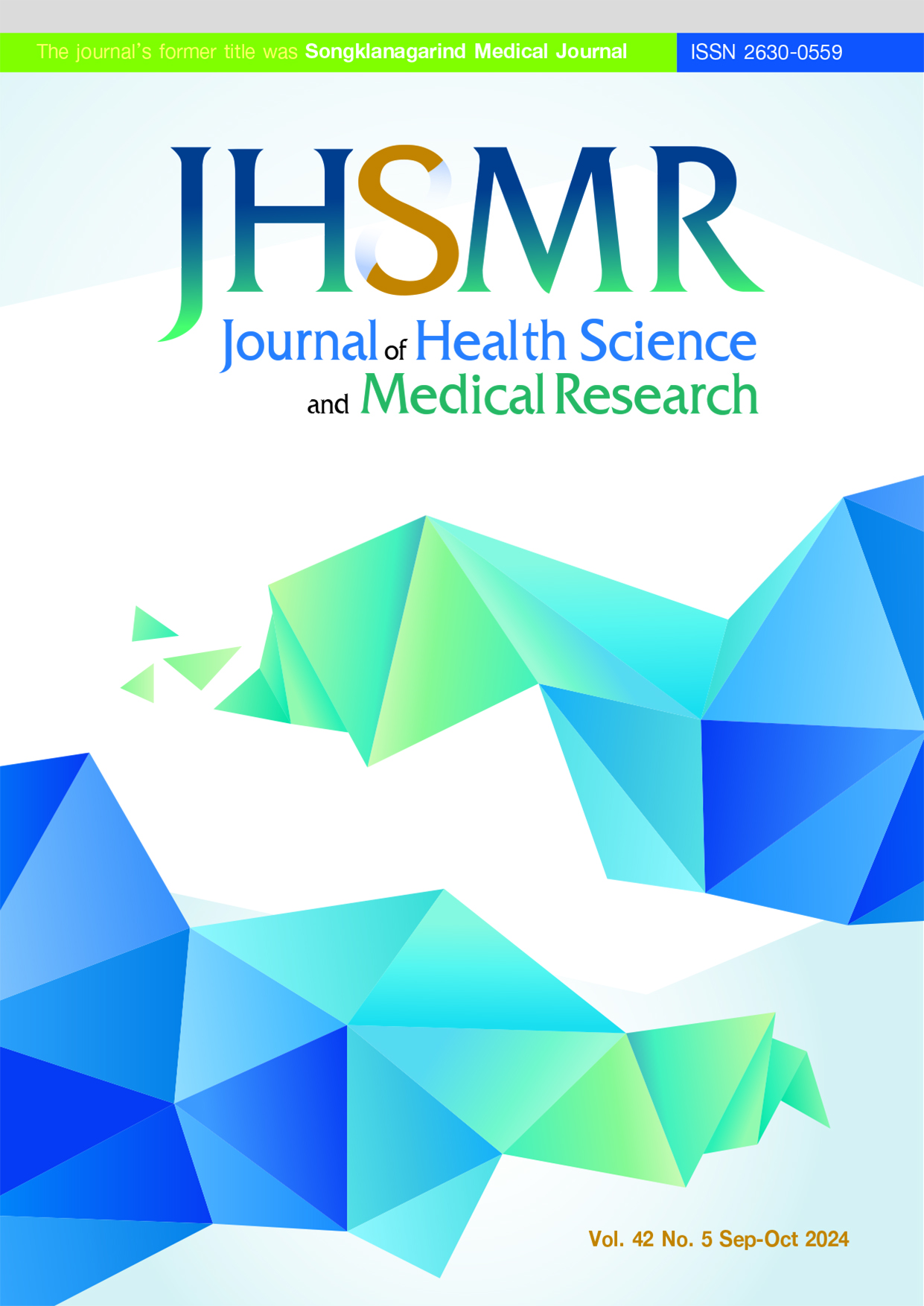Association of Low Back Pain Beyond Mid-Pregnancy with Maternal Physical Activity Prior to Pregnancy: A Cross-Sectional Study
DOI:
https://doi.org/10.31584/jhsmr.20241047Keywords:
adequate physical activity,, low back pain, pregnancyAbstract
Objective: 1) To compare the proportions of low back pain (LBP) in pregnant women with adequate and inadequate physical activity (APA and IPA, respectively) prior to pregnancy. 2) To identify possible factors associated with LBP during pregnancy.
Material and Methods: A cross-sectional analytic study was conducted. Pregnant women answered questions about their physical activity prior to and during pregnancy, using the Thai version of the short International Physical Activity Questionnaire (IPAQ), and assessed their lower back pain via the visual analog scale and the Thai version of the Oswestry Disability Index (ODI).
Results: A total of 342 pregnant women were enrolled. APA and IPA prior to pregnancy were detected in 172 and 170 cases, respectively. The proportions of LBP during pregnancy in each group were 61.6% and 64.7%, respectively. No statistically significant difference was found between the two groups (p-value=0.555). When adjusted with multiple factors in logistic regression model, APA prior to pregnancy decreased the risk of LBP during pregnancy (p-value=0.02), with an adjusted odds ratio (aOR) (95% CI) of 0.51 (0.281–0.916). In contrast, APA during pregnancy (p-value=0.01), pelvic pain (p-value<0.001), and LBP in a previous pregnancy (p-value<0.001) increased the risk of LBP during pregnancy, with aORs (95% CI) of 2.53 (1.236–5.197), 4.83 (2.563–9.110), and 7.49 (3.390–16.570), respectively.
Conclusion: APA prior to pregnancy and limiting some types of activity during pregnancy may have a protective effect on LBP during pregnancy.
References
Birsner ML, Gyamfi-Bannerman C. Physical activity and exercise during pregnancy and the postpartum period. ACOG Committee Opinion No. 804. Am J Obstet Gynecol 2020;135:e178-88.
Bhardwaj A, Nagandla K. Musculoskeletal symptoms and orthopaedic complications in pregnancy: pathophysiology, diagnostic approaches and modern management. Postgrad Med J 2014;90:450-60.
Sabino J, Grauer JN. Pregnancy and low back pain. Curr Rev Musculoskelet Med 2008;1:137-41.
Casagrande D, Gugala Z, Clark SM, Lindsey RW. Low back pain and pelvic paddle pain in pregnancy. J Am Acad Orthop Surg 2015;23:539-49.
Manyozo SD, Nesto T, Bonongwe P, Muula AS. Low back pain during pregnancy: prevalence, risk factors and association with daily activities among pregnant women in urban Blantyre, Malawi. Malawi Med J 2019;31:71-6.
Sencan S, Ozcan-Eksi EE, Cuce I, Guzel S, Erdem B. Pregnancy-related low back pain in women in Turkey: prevalence and risk factors. Ann Phys Rehabil Med 2018;61:33-7.
World Health Organization. WHO guidelines on physical activity and sedentary behaviour: at a glance [monograph on the Internet]. Geneva: WHO; 2020 [cited 2022 Jun]. Available from: https://apps.who.int/iris/bitstream/handle/10665/337001/9789240014886-eng.pdf
World Health Organization. Global status report on physical activity 2022 [monograph on the Internet]. Geneva: WHO; 2022 [cited 2022 Dec]. Available from: https://www.who.int/publications/i/item/9789240059153
Rodrigues WFG, Silva LRd, Nascimento MAdL, Pernambuco CS, Giani TS, Dantas EHM. Prevalence of lower back pain and physical inactivity: the impact of psychosocial factors in pregnant women served by the Family Health Strategy. Einstein (Sao Paulo) 2011;9:489-93.
Rattanawiwatpong P, Khunphasee A, Pongurgsorn C, Intarakamhang P. Validity and reliability of the Thai version of Short Format International Physical Activity Questionnaire (IPAQ). J Thai Rehabil 2006;3:147-60.
Sanjaroensuttikul N. The Oswestry low back pain disability questionnaire (version 1.0) Thai version. J Med Assoc Thai 2007;90:1417-22.
Berber MA, Satilmis IG. Characteristics of low back pain in pregnancy, risk factors, and its effects on quality of life. Pain Manag Nurs 2020;21:579-86.
Vermani E, Mittal R, Weeks A. Pelvic girdle pain and low back pain in pregnancy: a review. Pain Pract 2010;10:60-71.
Bryndal A, Majchrzycki M, Grochulska A, Glowinski S, Seremak-Mrozikiewicz A. Risk factors associated with low back pain among a group of 1,510 pregnant women. J Pers Med 2020;10:1-10.
Davenport MH, Marchand AA, Mottola MF, Poitras VJ, Gray CE, Jaramillo Garcia A, et al. Exercise for the prevention and treatment of low back, pelvic girdle and lumbopelvic pain during pregnancy: a systematic review and meta-analysis. Br J Sports Med 2019;53:90-8.
Todorovic J, Terzic-Supic Z, Bjegovic-Mikanovic V, Piperac P, Dugalic S, Gojnic-Dugalic M. Factors associated with the leisure-time physical activity (LTPA) during the first trimester of the pregnancy: the cross-sectional study among pregnant women in Serbia. Int J Environ Res Public Health 2020;17:1-12.
Aparicio VA, Marin-Jimenez N, Flor-Alemany M, Acosta-Manzano P, Coll-Risco I, Baena-Garcia L. Effects of a concurrent exercise training program on low back and sciatic pain and pain disability in late pregnancy. Scand J Med Sci Sports 2023;33:1201-10.
Hu X, Ma M, Zhao X, Sun W, Liu Y, Zheng Z, et al. Effects of exercise therapy for pregnancy-related low back pain and pelvic pain: a protocol for systematic review and meta-analysis. Medicine (Baltimore) 2020;99:1-7.
George JW, Skaggs CD, Thompson PA, Nelson DM, Gavard JA, Gross GA. A randomized controlled trial comparing a multimodal intervention and standard obstetrics care for low back and pelvic pain in pregnancy. Am J Obstet Gynecol 2013;208:295.e1-7.
Koukoulithras I Sr, Stamouli A, Kolokotsios S, Plexousakis M Sr, Mavrogiannopoulou C. The effectiveness of non-pharmaceutical interventions upon pregnancy-related low back pain: a systematic review and meta-analysis. Cureus 2021;13:1-12.
Shiri R, Coggon D, Falah Hassani K. Exercise for the prevention of low back and pelvic girdle pain in pregnancy: a meta analysis of randomized controlled trials. Eur J Pain 2017;22:19–27.
Santos FF, Lourenço BM, Souza MB, Maia LB, Oliveira VC, Oliveira MX. Prevention of low back and pelvic girdle pain during pregnancy: a systematic review and meta-analysis of randomised controlled trials with grade recommendations. J Physio 2023;118:1–11.
Downloads
Published
How to Cite
Issue
Section
License

This work is licensed under a Creative Commons Attribution-NonCommercial-NoDerivatives 4.0 International License.
























